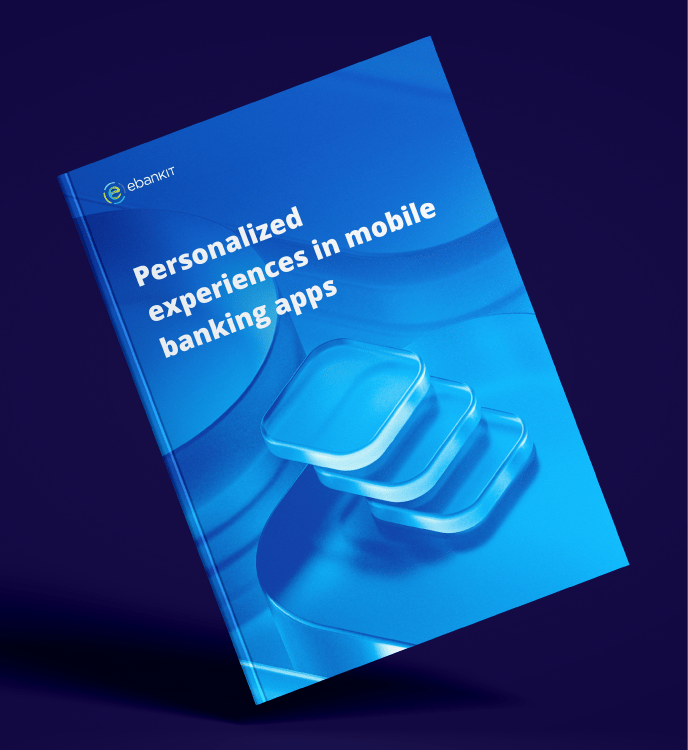At a glance
- 53% of banking customers worry about privacy, and 58% fear hacking risks. Cyber threats, data breaches, and fraud incidents seem to lurk at every corner.
- UI patterns build credibility, and a well-designed UX can attract customers and drive more conversions.
- Financial institutions should focus on creating clean and seamless digital experiences for their customers to foster trust and reap greater benefits.
- Discover five design practices that will build trust in your banking app.
Trust is a key component for financial institutions.
Trust crisis in the digital era - why financial institutions are at risk
Trust is a key component for financial institutions.
However, in today’s digital age, trust is hard to come by. Cyber threats, data breaches, and fraud incidents seem to lurk at every corner.
A 2025 industry study by Accenture found that 53% of banking customers worry about privacy, and 58% fear hacking risks when considering mobile banking.
The rise of AI does not help one bit, as it spreads misinformation rapidly, and digital users are becoming increasingly skeptical of what they see. AI's turmoil has already affected the media, and some industry experts think financial institutions are next in line.
These dynamics further increase the challenge for financial institutions striving to earn and maintain the trust of their account holders.
In a world where technology often feels impersonal or fake, how can banks, credit unions, or even community banks gain and keep the trust of their banking users?
Familiarity breeds trust
One should not judge a book by its cover, but one will judge your banking app.
Believe it or not, UI patterns build credibility, and a good UX design could attract customers and drive more conversions.
Familiarity and effortlessness create a sense of safety for users, which helps them become more comfortable using your banking interface to open accounts, make transactions, check account balances, or even ask for loans.
Research shows that user-centric strategies correlate strongly with higher financial results.
Companies that excel at design grow revenues and shareholder returns at nearly twice the rate of their industry peers. The research assessed more than 100,000 design actions from 300 publicly listed companies over a five-year period.
- The business value of design, McKinsey
So, financial institutions should focus on building clean and seamless digital experiences for their customers to build trust and reap more benefits.
Key benefits of a good UI design:
UX/UI inspired by big tech leaders
Modern digital banking and payment platforms like Revolut, American Express, or even Apple or Google have become leaders in fostering trust through their interface design.
Traditional financial institutions can learn a lot from them. Here’s how their design choices help account holders feel secure and confident:
Revolut - A human-centered design
Revolut uses human-centered design principles, which allow account holders to personalize dashboards to show relevant information at a glance, for example. They also provide instant transaction notifications, easy currency exchanges, and visual celebrations of budget goal achievements.
This improves customers’ overall experience within the app and makes them want to come back for more.
Not only that, Revolut’s app design turns usual complex actions into effortless operations. Stock trading or even cryptocurrencies become easy to understand, and account holders feel confident about them.
American Express - Emotional branding builds confidence
American Express uses emotional branding to connect with its customers, leveraging storytelling in app designs to foster emotional connections with users and create memorable experiences.
It also integrates offers directly within its app and website. This allows users to browse and redeem rewards seamlessly, eliminating the need for codes or coupons and providing a seamless and engaging digital experience.
Their app streamlines financial management with real-time notifications, instant fraud alerts, and secure digital payments. It offers users fast, reliable access to their accounts, improving customer engagement.
Fintech moves fast, don’t fall behind!
Apple - Simplicity and clarity
Apple is known for its clean, uncluttered interfaces. Their simplicity reduces cognitive load and helps users better understand what is happening with their money. This builds confidence and trust.
Another key point is that Apple made privacy visible. By using biometric technologies such as Face ID, Touch ID, and Secure Enclave across its ecosystem, Apple has made login operations less frustrating while keeping them secure.
Thanks to biometrics, users know that their accounts are safeguarded yet easy to access in a single step. As Steve Jobs said, “Design is not just what it looks like and feels like. Design is how it works.”
Google - Balancing data use with user control
Google provides clear notifications for every transaction, login, or security event, so users are always informed about the latest activity on their accounts.
Transparency in communication reassures users that the platform is actively protecting their interests and keeping them in the loop. It also layers security throughout the user journey rather than treating it as a single checkpoint.
Furthermore, despite handling vast amounts of data, Google maintains high trust through user control features like My Activity, ad personalization settings, and data download options.
5 design practices that build trust in your banking app
84% of consumers in a 2025 global survey said they would switch banks for better, more timely, and relevant financial insights, implying that trust in security and proactive fraud prevention is a key driver of loyalty.
1. Design for emotion
Deliver experiences that evoke positive emotions. Account holders want to open their banking app and feel reassurance and satisfaction.
Strengthening emotional ties with users begins by personalizing their digital journeys and aligning experiences to their individual preferences. By anticipating and addressing the unique needs of each user segment, digital banking becomes more intuitive and engaging.
This makes users feel recognized and valued, which increases their engagement and loyalty to your financial institution while diminishing the likelihood of seeking alternatives.
2. Consistent and intuitive navigation
Design consistency across platforms is essential and contributes to trust. It can establish credibility quickly and effectively. A consistent design language helps maintain visual harmony throughout the platform and reassures users that the product is reliable.
Provide your account holders with an omnichannel digital banking platform that offers simple navigation, an intuitive menu, and consistency across all banking channels. A good user experience creates a sense of reliability, which then fosters long-term loyalty to a bank.

3. Real-time notification alerts
Continuously monitor users' banking accounts for fraudulent activity and, if necessary, immediately notify customers of any suspicious transactions.
Empower customers to take immediate action, such as blocking a credit card, terminating access from a new device, or freezing the account, directly from the app.
This approach not only prevents fraud but also builds trust with customers, who appreciate the vigilance and responsiveness. Consumers are more likely to trust a bank that proactively communicates potential fraud.
4. Seamless authentication
Integrate security into natural workflows, reducing friction and enabling fast login. Biometric authentication offers advanced security measures, ensuring user safety and convenience with seamless verification processes.
Institutions like Metropolitan Commercial Bank leverage these systems to combat fraud proactively without sacrificing user experience.
Behavioral biometrics is also an emerging technology that tracks user behavior patterns to detect anomalies, significantly bolstering security.

5. Embedded finance
Embedded finance integrates financial services directly into everyday applications, delivering a seamless and unified user experience.
By embedding banking capabilities such as payments, lending, or account management within non-banking platforms like e-commerce sites or insurance apps, users gain convenient access to essential financial tools within the environments they already use.
This not only simplifies the buyer journey but also accelerates transactions, ultimately increasing conversion rates.
Trust is built, not bought
The institutions that will thrive will be those able to reinvent trust through seamless, human-centered digital experiences.
By prioritizing user needs, embedding proactive security, and leveraging innovation in design and integration, financial organizations can break through skepticism and deliver real value where it matters most.
The journey to regain and sustain trust starts by building platforms that place the customer at the center. Engaging, protecting, and empowering them at every step.
Now is the time for forward-thinking banks to embrace these principles, positioning themselves as trusted partners in the lives of their customers for the digital era ahead.
Curious to learn more?
Download our brochure to explore how you can accelerate your digital transformation with smarter design.





%20without%20SAM%20-%20Maturity%20Level%20-%202-KO%20edit.webp?width=160&height=57&name=67768-ebankIT%20Platform%20-%20CMMI%20Development%20V2.0%20(CMMI-DEV)%20without%20SAM%20-%20Maturity%20Level%20-%202-KO%20edit.webp)
